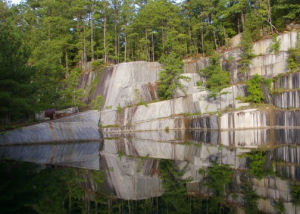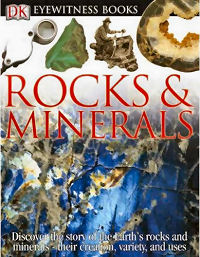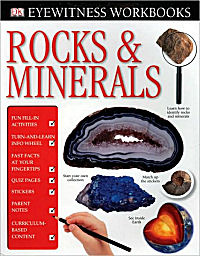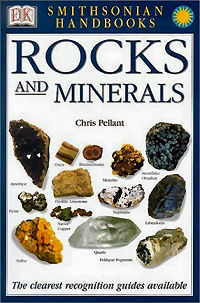
HOME
INTRO
SYMBOLS
ALMANAC
ECONOMY
GEOGRAPHY
STATE MAPS
PEOPLE
FORUM
NEWS
COOL SCHOOLS
STATE QUIZ
STATE LINKS
BOOK STORE
MARKETPLACE
NETSTATE.STORE
NETSTATE.MALL
GUESTBOOK
CONTACT US


South Carolina State Stone
Blue Granite, a light-blue or gray-colored igneous stone, became the official stone of South Carolina when House Bill No. 1808 (H1808) was signed by Governor Robert McNair on June 24, 1969. H1808 also named the amethyst the official gem stone of South Carolina.
(R494, H1808, A345)
AN ACT
TO DESIGNATE THE AMETHYST AS THE OFFICIAL STATE GEM STONE AND BLUE GRANITE AS THE OFFICIAL STATE STONE.
Whereas, South Carolina is one of three states where the gem stone amethyst of good quality is found in the United States; and
Whereas, the curator of mineralogy for the Smithsonian Institute has graded one of the largest early specimens from this State as the finest seen in the country; and
Whereas, such stone now holds first place in the amethyst section in the Institute; and
Whereas, the amethyst is the most prized type of quartz for its wide use and various shades and hue from deep orchid color; and
Whereas, the blue granite stone of this State has been widely used to beautify all areas of South Carolina; and
Whereas, South Carolina has a state flag, a state flag, a state song, a state bird, a state flower, a state tree; and
Whereas, in preparing for the Three-hundredth Anniversary of the founding of this State, it is only fitting that a State gem stone and a state stone be officially adopted. Now, therefore,
Be it enacted by the General Assembly of the State of South Carolina:
SECTION 1. Official gem of State.--The amethyst is the official gem stone of the State.
SECTION 2. Official stone of State.--Blue granite is the official stone of the State.
SECTION 3. Time effective.--This act shall take effect upon approval by the Governor.
Approved the 24th day of June, 1969
----------

Official State Stone: Blue Granite
Anderson Quarry, Fairfield County, S.C.
Photo: Duane Burdick - (Flickr) published under the terms
of the Creative Commons Attribution 2.0 License
South Carolina Law
The following information was excerpted from the The South Carolina Code of Laws, title 1, chapter 1, article 9, section 1-1-620.
Title 1 - Administration of the Government
CHAPTER 1. GENERAL PROVISIONS
ARTICLE 9. STATE EMBLEMS, PLEDGE TO STATE FLAG, OFFICIAL OBSERVANCES
SECTION 1-1-620.
SECTION 1-1-620. Official State stone.
Blue granite is the official stone of the State.
Sources...
State of South Carolina. South Carolina Code of Laws. Columbia: State of South Carolina, 2011. Web. 8 Jun 2011.
Shearer, Benjamin F. and Barbara S. State Names, Seals, Flags and Symbols: A Historical Guide Third Edition, Revised and Expanded. Westport, Conn: Greenwood Press, 3 Sub edition, 2001.
Additional Information
Gems, Rocks & Gardens: South Carolina State House Student Connection.
South Carolina State Stone – Blue Granite: SCIWAY . . . "sky-way" . . . South Carolina's Information HighWAY.
Fairfield County Granite Quarry - Winnsboro, South Carolina: SCIWAY . . . "sky-way" . . . South Carolina's Information HighWAY.
State Rocks: Complete list of official state rocks, stones, gem stones and minerals from NETSTATE.COM.
More symbols & emblems: Complete list of official South Carolina state symbols from NETSTATE.COM.

Eyewitness Books: Rocks & Minerals
Eyewitness Books: Rocks & Minerals, by Chris Pellant, R.F. Symes 72 pages. DK CHILDREN (August 2, 2004) Reading level: Ages 9-12. Here is a spectacular and informative guide to the amazing world beneath our feet. Stunning color photographs of rocks, fossils, minerals, precious metals, crystals, jewels and gemstones give the reader a unique "eyewitness" insight into the evolution and composition of the Earth. See rocks that have come from outer space, stalactites as old as dinosaurs, the strange and beautiful shapes of natural crystals and priceless nuggets of gold, silver and platinum. Learn what the Earth is made of - and how its rocks were formed, how early humans made the first flint tools and how diamonds and precious stones are cut, polished, and made into jewelry. Discover how prehistoric animals are preserved today as fossils, how volcanoes work, how rocks are formed from molten lava, how minerals and metals are mined and how pebbles on the seashore are worn down into sand, and much, much more!

Eywitness Workbook: Rocks & Minerals
Eyewitness Workbooks: Rocks & Minerals, 48 pages. DK CHILDREN; Workbook edition (June 16, 2008) Reading level: Ages 9-12. Perfect for getting ahead at school or just stimulating children's interest, this groundbreaking series of workbooks leaves the competition in the dust, with exciting subjects, 48 full-color pages, a turn-and-learn info wheel, and special carrying folders. Never before have there been workbooks with so many opportunities for fun and interactive learning!
Peterson First Guides: Rocks and Minerals, by Frederick H. Pough. 128 pages. Houghton Mifflin Harcourt (August 15, 1998) Written and designed for the beginner, this book describes and illustrates the most common and interesting rocks and minerals, from simple sandstone to exotic gems. Illustrated with dozens of beautiful color photographs, it tells how these rocks and minerals formed and how to identify them--and includes tips on collecting.
Rocks & Minerals, by Dougal Dixon. 160 pages. Fireside (August 15, 1992) Beginning with a history of the earth's formation and development, this book explores the substances that compose the planet, movements within the earth, the surface effects of weather and water, and underground landscapes. It shows you how to search for, identify, and extract samples of various rocks and minerals, and for each rock and mineral type there is a brief mineralogy and explanation of its locations. There are also sections on mapping, preparing, and curating specimens, and geological sites on the six continents. Packed with more than 200 full-color illustrations, this comprehensive guide is the essential practical companion for natural science enthusiasts everywhere.

Rocks and Minerals
by Chris Pellant
Smithsonian Handbooks: Rocks and Minerals, by Chris Pellant. 256 pages. DK ADULT; 1st edition (September 1, 2002) The Smithsonian Handbook of Rocks and Minerals combines 600 vivid full--color photos with descriptions of more than 500 specimens. This authoritative and systematic photographic approach, with words never separated from pictures, marks a new generation of identification guides. Each entry combines a precise description with annotated photographs to highlight the chief characteristics of the rock or mineral and distinguishing features.
Field Guide to North American Rocks and Minerals, National Audubon Society. 856 pages. Knopf; 1st Edition (5th Printing) edition (May 12, 1979) Perfect for mountain climbers and hikers, this valuable reference covers more rocks and rocks in North America than any other available guide. 794 full-color photographs depict all the important rocks, gems, and rocks -- in many variations of color and crystal form -- and the natural environments in which they occur; written descriptions provide information on field marks, similar rocks and rocks, environment, areas of occurrence, and derivation of names. Includes a guide to rock collecting and a list of rock-forming rocks

